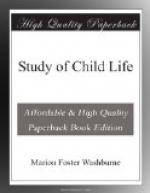Note.—After completing the test sign your full name.
[Illustration: MADONNA AND CHILD
By Murillo, Spanish painter of the seventeenth century]
STUDY OF CHILD LIFE
PART III
ART AND LITERATURE IN CHILD LIFE
The influence of art upon the life of a young child is difficult of measurement. It may freely be said, however, that there is little or no danger in exaggerating its influence, and considerable danger in underrating it. It is difficult of measurement because the influence is largely an unconscious one. Indeed, it may be questioned whether that form of art which gives him the most conscious and outspoken pleasure is the form that in reality is the most beneficial; for, unquestionably, he will get great satisfaction from circus posters, and the poorly printed, abominably illustrated cheap picture-books afford him undeniable joy. He is far less likely to be expressive of his pleasure in a sun-shiny nursery, whose walls, rugs, white beds, and sun-shiny windows are all well designed and well adapted to his needs. Nevertheless, in the end the influence of this room is likely to be the greater influence and to permanently shape his ideas of the beautiful; while he is entirely certain, if allowed to develop artistically at all, to grow past the circus poster period.
This fact—the fact that the highest influence of art is a secret influence, exercised not only by those decorations and pictures which flaunt themselves for the purpose, but also by those quiet, necessary, every-day things, which nevertheless may most truly express the art spirit—this fact makes it difficult to tell what art and what kind of art is really influencing the child, and whether it is influencing him in the right directions.
[Sidenote: Color]
Until he is three years old, for example, and often until he is past that age, he is unable to distinguish clearly between green, gray and blue; and hence these cool colors in the decorations around him, or in his pictures, have practically no meaning for him. He has a right, one might suppose, to the gratification of his love for clear reds and yellows, for the sharp, well-defined lines and flat surfaces, whose meaning is plain to his groping little mind. Some of the best illustrators of children’s books have seemed to recognize this. For example, Boutet de Monvil in his admirable illustrations of Joan of Arc meets these requirements perfectly, and yet in a manner which must satisfy any adult lover of good art. The Caldecott picture books, and Walter Crane’s are also good in this respect, and the Perkins pictures issued by the Prang Educational Co. have gained a just recognition as excellent pictures for hanging on the nursery wall. Many of the illustrations in color in the standard magazines are well worth cutting out, mounting and framing. This is especially true of Howard Pyle’s work and that of Elizabeth Shippen Green.




